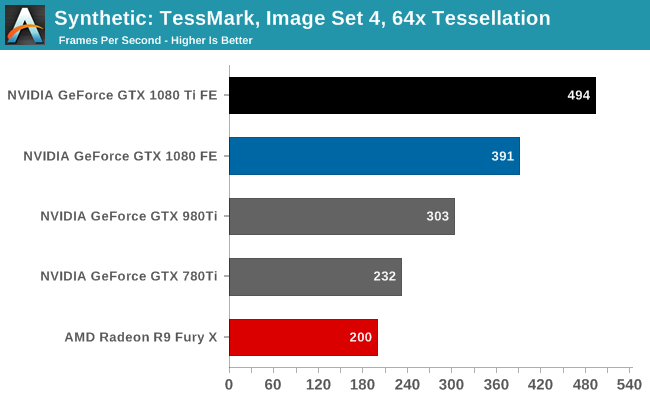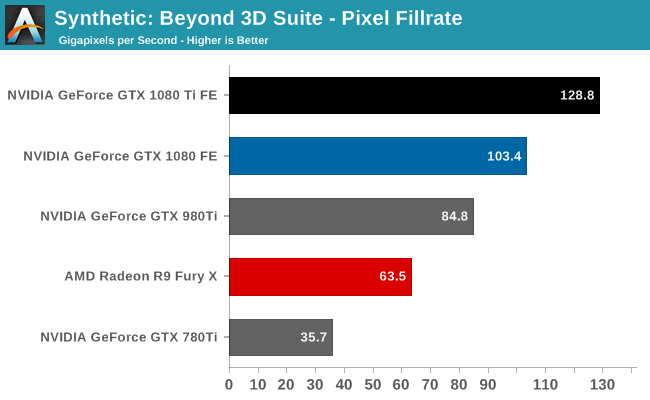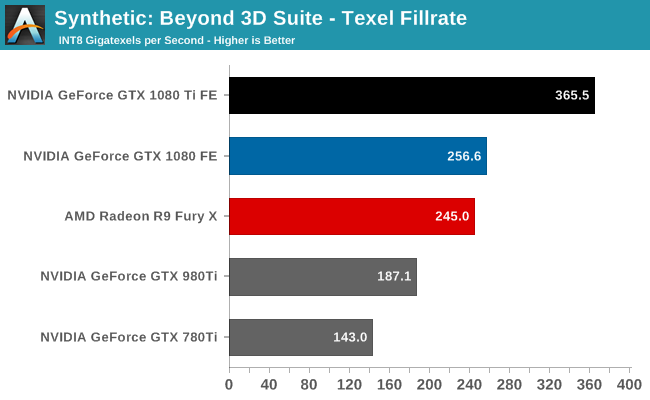The NVIDIA GeForce GTX 1080 Ti Founder's Edition Review: Bigger Pascal for Better Performance
by Ryan Smith on March 9, 2017 9:00 AM ESTSynthetics
As always we’ll also take a quick look at synthetic performance. As a pretty straightforward and wider implementation of Pascal, GTX 1080 Ti shouldn't offer too many surprises here.

With TessMark, we find that the that the GTX 1080 Ti offers 26% better tessellation performance than the GTX 1080, and 63% better performance than the GTX 980 Ti. NVIDIA has always built their architectures geometry-heavy, and GTX 1080 Ti further adds to that lead.
Finally, for looking at texel and pixel fillrate, we have the Beyond3D Test Suite. This test offers a slew of additional tests – many of which use behind the scenes or in our earlier architectural analysis – but for now we’ll stick to simple pixel and texel fillrates.


As it turns out, the pixel fillrate results for the GTX 1080 Ti are a bit surprising. The GTX 1080 Ti doesn’t dominate by as much as I would have expected given the massive memory bandwidth advantage and additional ROP throughput. Not that a 25% increase over the GTX 1080 is anything to sneeze at, but I wonder if we’re looking at one of the consequences of the unusual way NVIDIA has cut-down GP102 for GTX 1080 Ti. We haven’t seen NVIDIA disable a single ROP/memory channel at the high-end before in this manner.
As for texel fillrate, the GTX 1080 Ti excels. In fact it does a bit better than I’d otherwise expect based on the specifications. This could be a sign that GTX 1080 is a bit bandwidth limited at times when it comes to texel throughput, as that’s the facet of performance the GTX 1080 Ti has improved upon the most.










161 Comments
View All Comments
SaolDan - Thursday, March 9, 2017 - link
i dont need it but i really want it. currently gaming and vr on a 1070 and loving it.Endda - Thursday, March 9, 2017 - link
Would have loved to see the Titan XP in those graphsRyan Smith - Thursday, March 9, 2017 - link
Unfortunately NVIDIA never sampled us on that one, so I don't have one on-hand to test again.Samus - Thursday, March 9, 2017 - link
Can't wait to pickup one of these in a year for ~$400. Easily future-proof for the next generation of console games, and my 780Ti is really showing its age, by about 154%...Nfarce - Friday, March 10, 2017 - link
If you think you are going to see a 1080Ti in 12 months selling for $400, I've got a like-new Ferrari to selling you for $15k. It will be nearly summer before the AIB GPUs (ASUS, EVGA, Gigabyte, MSI, etc.) start becoming available in decent supply.rtho782 - Thursday, March 9, 2017 - link
I know I'm an outlier, but having lived with SLI 980s for a couple of years I'm looking to go back to a single card, and I really wish I could find SLI 980 to 1080ti benchmarks :PDrumsticks - Thursday, March 9, 2017 - link
I think the original AT review of the 1080 compares them. Go there and just tack on another 30% maybe?mapesdhs - Saturday, March 11, 2017 - link
If it's of any help, I've done a fair few 980 SLI tests for 3DMark, Unigine, etc., you could compare those to 1080 Ti reviews (several sites have included 3DMark results, and Techpowerup has a couple of Unigine results threads/tables); PM me for links, or email (Google "Ian SGI", find the Contact page, use my Yahoo address).Achaios - Thursday, March 9, 2017 - link
It should be borne in mind that Benchmark results are misleading, especially when referring to the 780TI.The 780TI launched at ridiculously low clocks of 875MHz Core Clock and 928 MHz Boost Clock, which wasn't much different from what a GTX 580 OC'd could do.
When overclocked, the 780TI worked at around 1.25 GHz, a huge difference over the stock card.
So, while the 1080TI has got more than double the performance of an OC'd 780TI as per 3D Mark Firestrike, the performance shown herein for the 780TI is ridiculously low and thus, misleading.
Yojimbo - Thursday, March 9, 2017 - link
I guess if you're worried about someone making judgments of general GPU trends without fully researching it, that's true. But owners of 780 Ti cards should be aware of where their individual cards sit compared to the reference design. In any case it's always going to be hairy taking overclocking performance into account when making judgments about generational trends. For instance, 2017 1060s and 1080s are going to be able to overclock better than 2016 1060s and 1080s. There's also a whole range of clock speeds that come out. Do you take the fastest or the average? If you take the average do you take the average of the SKUs or an average weighted by units sold? It's not so easy to get an accurate picture without a lot of work.